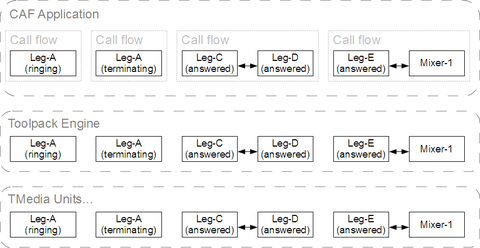CAF: Call Legs Resync
| Line 41: | Line 41: | ||
=== Scenario 1: toolpack_engine quickly restarted === | === Scenario 1: toolpack_engine quickly restarted === | ||
| − | [[Image:CAFCallFlow_examples_scenario_1.png|thumb|480px|Example scenario | + | [[Image:CAFCallFlow_examples_scenario_1.png|thumb|480px|Example scenario 1]] |
* CAF Application is notified | * CAF Application is notified | ||
| Line 64: | Line 64: | ||
=== Scenario 2: toolpack_engine stopped (disconnected) for more than 10 seconds === | === Scenario 2: toolpack_engine stopped (disconnected) for more than 10 seconds === | ||
| − | [[Image:CAFCallFlow_examples_scenario_2.png|thumb|480px|Example scenario | + | [[Image:CAFCallFlow_examples_scenario_2.png|thumb|480px|Example scenario 2]] |
* CAF Application is notified | * CAF Application is notified | ||
| Line 101: | Line 101: | ||
=== Scenario 3: CAF application is restarted === | === Scenario 3: CAF application is restarted === | ||
| − | [[Image:CAFCallFlow_examples_scenario_3.png|thumb|480px|Example scenario | + | [[Image:CAFCallFlow_examples_scenario_3.png|thumb|480px|Example scenario 3]] |
This is exactly same scenario as the end of Scenario 2 after toolpack_engine pushes information to CAF library. | This is exactly same scenario as the end of Scenario 2 after toolpack_engine pushes information to CAF library. | ||
Revision as of 07:42, 19 October 2012
Contents |
Call Legs Resynchronization
Since the Toolpack framework has been designed for HA (High_Availability_Overview), it's mandatory that an application that manage calls through CAF_Call_interface is able to deal with call legs re-synchronization.
The current page contains an overview of how re-synchronization works. For more details, please refer to the following section of the this page:
CAF:_Working_With_Caf_Call_Legs#Re-synchronizing_with_toolpack_engine
Situations where call leg resynchronization is required
Call legs re-synchronization is required whenever the CAF application looses communication with toolpack_engine:
- The CAF application was restarted
- The toolpack_engine was restarted
- Network connection between CAF application and toolpack_engine was momentarily down
General principles of call legs re-sync
Toolpack Engine
The toolpack_engine application, when restarted, will re-build it's call leg contexts by querying information on the TMedia Units.
- Transient calls (not yet answered) will be dropped
- Terminating calls will be dropped
- Active (answered) calls will be re-build like they were before toolpack_engine was restarted
CAF application
The CAF call control application that was disconnected from toolpack_engine will update (or re-build) it's call leg contexts by getting information automatically pushed by toolpack_engine upon re-connection.
All active (answered) calls will be re-synchronized from toolpack_engine.
- Calls already known by the application will remain valid
- Calls unknown by the application will be re-constructed (or refused): OnCallLegSync, OnLinkSync
- Calls known by the application, but no more present in toolpack_engine are terminated: OnCallLegTerminated
Example scenarios
In all the scenarios below, let's consider the following situation:
- Leg-A: Ringing
- Leg-B: Terminating
- Leg-C: Active (answered)
- Leg-D: Active (answered)
- Leg-E: Active (answered)
- Leg-C and Leg-D are joined (connected) together
- Mixer-1: Ready
- Leg-E and Mixer-1 are joined (connected)
Scenario 1: toolpack_engine quickly restarted
- CAF Application is notified
- OnCmcLibNotReady()
- OnSyncLost() for Leg-A, Leg-B, Leg-C, Leg-D and Leg-E
- OnMixerSyncLost() on Mixer-1
- toolpack_engine restarts
- Queries information from all TMedia units
- Drop incomplete legs and mixers (here Leg-A and Leg-B)
- Re-build contexts for active legs and mixers (here Leg-C, Leg-D, Leg-E and Mixer-1)
- Re-build connections between legs/mixers (here Leg-C with Leg-D, Leg-E with Mixer-1)
- toolpack_engine pushes information to CAF library:
- Legs: Leg-C, Leg-D and Leg-E
- Mixers: Mixer-1
- Connections: Leg-C with Leg-D, Leg-E with Mixer-1
- CAF library compares with it's own contexts:
- OnCallLegTerminated() for Leg-A and Leg-B
- OnSyncDone() for Leg-C, Leg-D and Leg-E
- OnMixerSyncDone() for Mixer-1
- Ready to continue
- OnCmcLibReady()
Scenario 2: toolpack_engine stopped (disconnected) for more than 10 seconds
- CAF Application is notified
- OnCmcLibNotReady()
- OnSyncLost() for Leg-A, Leg-B, Leg-C, Leg-D and Leg-E
- OnMixerSyncLost() on Mixer-1
(... 10 seconds elapse...)
- CAF Application declares toolpack_engine "dead", destroys all it's local contexts:
- OnCallLegTerminated() for all legs: Leg-A, Leg-B, Leg-C, Leg-D and Leg-E
- OnMixerTerminated() for all mixers: Mixer-1
(... some time elapse...)
- toolpack_engine is restarted
- Queries information from all TMedia units
- Drop incomplete legs and mixers (here Leg-A and Leg-B)
- Re-build contexts for active legs and mixers (here Leg-C, Leg-D, Leg-E and Mixer-1)
- Re-build connections between legs/mixers (here Leg-C with Leg-D, Leg-E with Mixer-1)
- toolpack_engine pushes information to CAF library:
- Legs: Leg-C, Leg-D and Leg-E
- Mixers: Mixer-1
- Connections: Leg-C with Leg-D, Leg-E with Mixer-1
- CAF library compares with it's own contexts (none!):
- OnCallLegSync() for Leg-C, Leg-D and Leg-E
- Application may refuse them: RefuseLeg()
- Application may re-allocate new contexts for these legs
- OnMixerSync() for Mixer-1
- Application may refuse: RefuseMixer()
- Application may re-allocate new contexts for these mixers
- OnLinkSync() for Leg-C with Leg-D
- Application may refuse: RefuseLink()
- Application may re-allocate new "call flow" contexts, re-bind legs to them (BindCallLeg)
- OnMixerLinkSync() for Leg-E with Mixer-1
- Application may refuse: RefuseMixerLink()
- Application may re-allocate new "call flow" contexts, re-bind legs/mixers to them (BindCallLeg, BindMixer)
- OnCallLegSync() for Leg-C, Leg-D and Leg-E
- Ready to continue
- OnCmcLibReady()
Scenario 3: CAF application is restarted
This is exactly same scenario as the end of Scenario 2 after toolpack_engine pushes information to CAF library.
For more information...
The current page contains an overview of how re-synchronization works. For more details, please refer to the following page:
CAF:_Working_With_Caf_Call_Legs#Re-synchronizing_with_toolpack_engine



